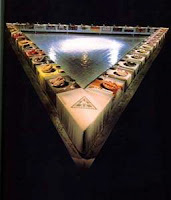The Dinner Party

Poor Brooklyn Museum. In any other city, it would be a world-class destination, on every tourist’s “must-see” list. But it’s here, and thus it lives in the immense shadow of MoMA and the Met. Cheaper and quieter than its Manhattan counterparts, the Brooklyn Museum is certainly worth a visit, in part because of a recent acquisition: The Dinner Party, by Judy Chicago.
This huge, triangular installation celebrates women’s contributions to western civilization. (Each side measures 48 feet.) The most important piece of feminist art produced in the 1970s was simultaneously lighter and creepier than I’d expected.
Chicago has given 39 women, ranging from Virginia Woolf to Sappho to Judith to Kali, decorated place settings at the table. Each setting has a placemat embroidered with the woman’s name and a motif related to her life or achievements, as well as an oversized plate, with a uniquely designed take on a butterfly or vulva. Most plates have two-dimensional designs, but some are three-dimensional—their pink, white, or mauve shapes rising up several inches. Beneath the table are white tiles, on which Chicago has written the names of 999 other important women in pretty gold script.
The Dinner Party will anchor the new Sackler Center devoted to feminist art. Like many viewers, I was lukewarm about the current work on show: though I adamantly believe in having a gallery devoted to feminist art, I felt the boundaries imposed by the curators (women artists born after 1970, whose work was then lumped into categories like “Emotion” and “Identity”) too restrictive. Where are the paintings and sculpture (video installations and photographs dominate)? Where are the men? Time will answer these questions and thus maybe alter my initial impressions.
Comments
Post a Comment